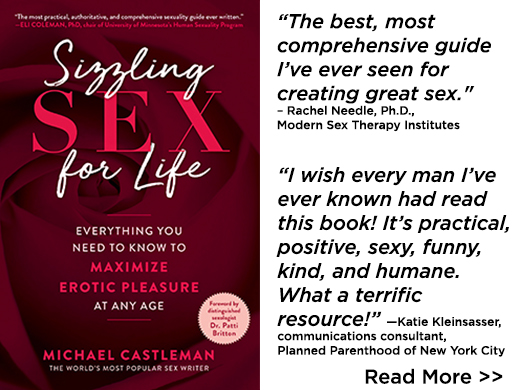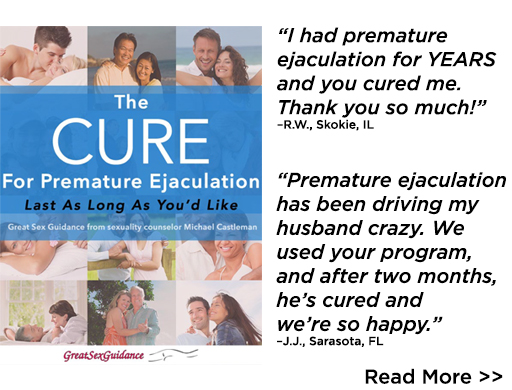
Could sex raise men’s risk for prostate cancer? That disturbing possibility has been raised by several studies over the past 10 years. Prostate cancer is to men what breast cancer is to women. It currently strikes 232,000 American men annually and kills 30,000—numbers similar to the toll of breast cancer on women.
More Sex, Greater Risk?
Here are summaries of selected studies suggesting a sex-prostate cancer link:
* Italian researchers found that compared with men who never married, those who were married—and presumably had more sex—had significantly greater risk of prostate cancer. For men married more than twice, risk was three times that of never-married men.
* University of Illinois researchers correlated prostate cancer risk with men’s age at first intercourse and estimated lifetime number of women sex partners. The younger the men became sexually active, the greater their risk. And the more sex partners they reported, once again, the greater their risk.
* And University of Iowa researchers found that as the number of women sex partners increased, so did risk of prostate cancer, with men who reported sex more than three times a week showing the greatest risk.
More Sex, Less Risk?
But the largest study shows just the opposite—that frequent sex protects against prostate cancer. This study, by researchers at the National Cancer Institute, Johns Hopkins, and Harvard, surveyed 29,000 men, aged 46 to 81, who were asked to estimate their number of weekly ejaculations during their twenties, their forties, and during the past year. Compared with men who reported seven or fewer ejaculations per month (especially during their twenties), the men who experienced 21 or more were 33 percent less likely to develop prostate cancer.
So what’s going on? Does frequent sex contribute to prostate cancer? Or protect against it?
The Link to Sexually Transmitted Infections
The smart money says sex is protective. In medical research, the larger the study, the more valid it is likely to be. The studies showing that sex increases prostate cancer risk involved a few hundred men. The study showing that sex reduces risk involved 29,000.
But if sex reduces risk of prostate cancer, it’s only protective if men avoid sexually transmitted infections (STIs). In women, infection with genital warts substantially boosts risk of cervical cancer. In fact, many experts now consider cervical cancer an STI. Researchers wondered if STIs might also increase risk of prostate cancer.
Many studies—including the University of Iowa study discussed above— show that a history of STIs, especially gonorrhea and syphilis, approximately doubles prostate cancer risk. It’s not entirely clear how STIs spur development of prostate cancer, but these infections cause inflammation and other cellular disruptions, which apparently either trigger cancerous cell changes, or accelerate the growth of slow-growing cancers.
Many studies have linked frequency of sex and an increasing number of sex partners to increased risk of STIs. So it now seems likely that it’s the STIs, not the sex per se, that increases prostate cancer risk in the studies showing that finding. It seems increasingly likely, that like cervical cancer, prostate cancer is, at least to some extent, sexually transmitted.
“Hey, Babe, Let’s Prevent Prostate Cancer Tonight.”
Women might be hearing more of that come-on line if subsequent studies confirm that sex protects against prostate cancer. Or maybe not. The large study tracked ejaculations, but did not distinguish between those that occurred during partner sex or masturbation. If a woman is not in the mood to help her man prevent prostate cancer, men can reduce their risk solo.
Nonsexual Ways To Reduce Prostate Cancer Risk
* Eat less meat and dairy. The animal (saturated) fat in meats and diary products has been strongly linked to increased risk of prostate cancer.
* Eat more fruits and vegetables. The antioxidant nutrients found in plant foods (but not animal foods) help reduce risk of all cancers, including prostate.
* Eat more tomato foods. Among fruits and vegetables, tomatoes are the most strongly protective against prostate cancer. Tomatoes contain an antioxidant, lycopene, a form of vitamin A, which has been shown to substantially reduce risk of prostate cancer. Any tomato products help, but the best involve cooked tomatoes: tomato soup, sauce, pizza, etc. Cooking makes lycopene more available to the body.
* Eat more fish. Fish tends to displace meat in the diet, and less meat means less risk of prostate cancer. In addition, cold water fish, especially salmon, contain omega-3 fatty acids that recent studies show help reduce risk of prostate cancer.
* Take a multivitamin with selenium. Selenium is a potent antioxidant nutrient found in plant foods. But the amount in food depends on the selenium content of the soil in which it was grown, and some soils are low in this nutrient. It’s prudent to take a supplement. Look for multivitamins that contain 50 to 100 micrograms (mcg).
* Finally, to prevent STIs, if you or your partner is nonmonogamous, use condoms every time.
References:
Dennis, LK and DV Dawson. “Meta-Analysis of Measures of Sexual Activity and Prostate Cancer.” Epidemiology (2002) 13:72.
LaVecchia, C et al. “Marital Status, Indicators of Sexual Activity, and Prostatic Cancer,” Journal of Epidemiology and Community Health (1993) 47:450.
Leitzmann, MF et al. “Ejaculation Frequency and Subsequent Risk of Prostate Cancer,” Journal of the American Medical Association,” (2004) 291:1578.
Rosenblatt, KA et al. “Sexual Factors and Risk of Prostate Cancer,” American Journal of Epidemiology (2001) 153:1152.




